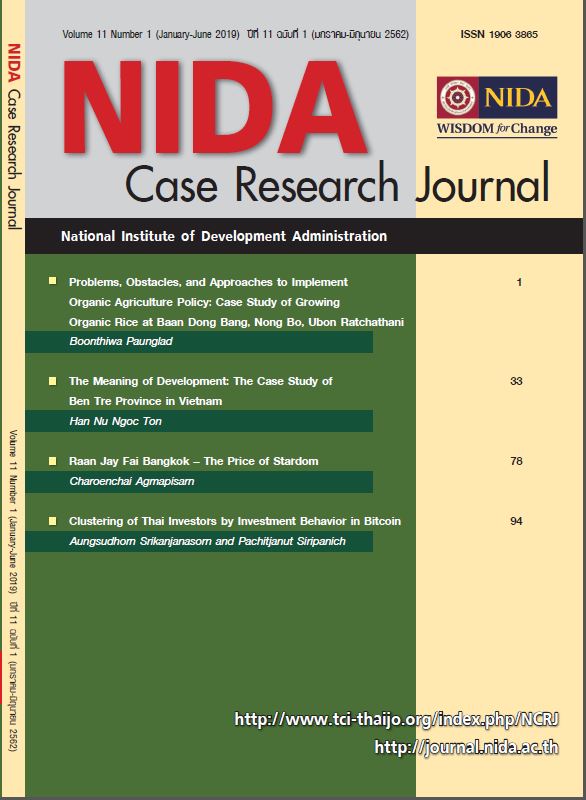Clustering of Thai Investors by Investment Behavior in Bitcoin
Keywords:
Cluster Analysis, Investment Behavior, Bitcoin, Thai InvestorsAbstract
This research aims to cluster Thai investors according to their investment behavior in Bitcoin and to study the specific behavior of investors in each group. There were 389 Bitcoin investors which collected by using the quota sampling method and using online questionnaires.
The study indicated that a group of Thai investors who invest in Bitcoin could be divided into 3 groups with the different characteristics are as follows: Group 1 is a group of investors who invest for socialize and to exchange news. There is only one Bitcoin address and invested by trading for the most speculative only. Also, having the least investment experience in Bitcoin, therefore named Group 1 as "Amateur Investors." Next, Group 2, the investors of this group are speculating and are invested in Bitcoin for additional opportunities to increase revenue. There are more than 3 Bitcoin address and invest by both mining and trading for speculation. Besides, friends have influence on the decision to invest in Bitcoin and this group of investors possesses Bitcoin in small increments. Therefore, second group is named "Serious Speculators". Finally, Group 3, these investors invest for diversification and also have Bitcoin address from 4 or more. They invest by both mining and trading for speculation. Moreover, investors have confidence in themselves and considered by analysts/media. Besides, there is also the most investment experience in Bitcoin, and there is a lot of bitcoin possession. Therefore, the group name is called " Investors for Diversification ".
References
Caccam, M., & Refran, J. (2012). Clustering analysis. Retrieved June 14, 2019, from https://www.slideshare.net/jewelmrefran/cluster-analysis-15529464
Farell, R. (2015). An analysis of the cryptocurrency industry. Wharton Research Scholars Journal, Paper 130.
Glaser, F., Zimmermann, K., Haferkorn, M., Weber, M. C., & Siering, M. (2014). Bitcoin-asset or currency? revealing users' hidden intentions. Revealing Users' Hidden Intentions (April 15, 2014). ECIS.
Hirschey, M., & Nofsinger, J. R. (2008). Investments: analysis and behavior. Boston: McGraw-Hill Irwin.
Siamblockchain. (2019). What is Bitcoin. Retrieved June10, 2019, from https://siamblockchain.com/bitcoin-%E0%B8%84%E0%B8%B7%E0%B8%AD-%E0%B8%AD%E0%B8%B0%E0%B9%84%E0%B8%A3/
Srikanjanasorn, A. (2019). Clustering of Thai Investors by Investment Behavior in Thailand (Master’s thesis). National Institute of Development Administration.
Strong, R. A. (1998). Practical investment management. Cincinati, Ohio: South-Western College.
Sullivan, M. K., & Miller, A. (1996). Segmenting the Informal Venture Capital Market: Economic, Hedonistic, and Altruistic Investors. Journal of Business Research, 36, 25-35.
The Stock Exchange of Thailand. (2014). Financial Market and Securities Investment, Securities Investment Consultant (20 Ed.). Bangkok: The Stock Exchange of Thailand.





